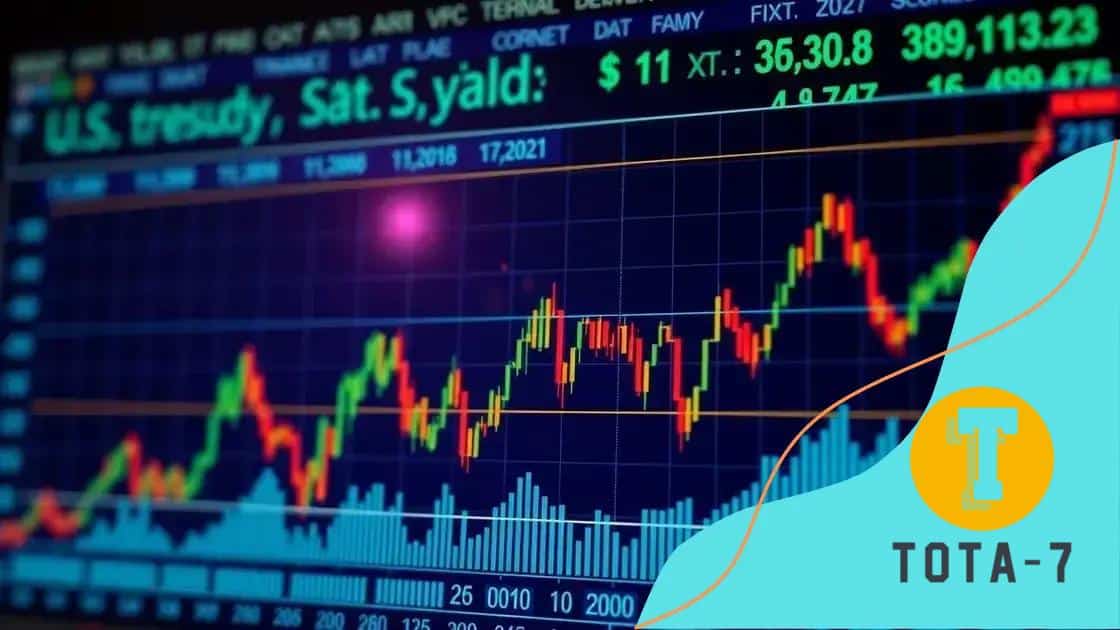U.S. treasury yield curve sends mixed economic signals

The U.S. treasury yield curve signals economic conditions; a normal curve indicates growth while an inverted curve suggests potential recessions, guiding investment strategies and business planning.
U.S. treasury yield curve sends mixed economic signals, leaving many puzzled about its implications. Could these fluctuations influence your investment decisions? Let’s unpack what this means for the economy.
Understanding the treasury yield curve
Understanding the treasury yield curve is essential for grasping the dynamics of financial markets. This curve represents the relationship between interest rates and the time to maturity of U.S. government bonds. By analyzing it, investors can gain insights into economic expectations and make informed decisions.
What is the Treasury Yield Curve?
The treasury yield curve shows the yields (interest rates) of U.S. government bonds at various maturities, from short-term to long-term. Typically, it slopes upward, indicating that longer-term bonds yield more interest than shorter ones. This difference reflects the risk and time preferences of investors.
Importance of the Yield Curve
The yield curve serves as a powerful economic indicator. It helps assess future interest rate changes and economic activity. When the curve is steep, it suggests growth, while an inverted curve may signal an upcoming recession. Investors closely watch these changes:
- Indications of economic growth.
- Future interest rate expectations.
- Market sentiment on risk.
Understanding how the yield curve shifts can aid in predicting market movements. Factors like inflation, Federal Reserve policies, and global events can all impact these changes.
The yield curve is not just a financial tool; it reflects broader economic realities. By paying attention to its shape, investors can anticipate shifts in the economy. For example, significant flattening may indicate a slowdown in growth expectations, while steepening could suggest optimistic prospects ahead. The treasury yield curve thus serves as a key touchpoint for both policymakers and investors alike.
Historical context of yield curve movements

The historical context of yield curve movements provides valuable insights into how economic conditions have changed over time. Understanding these shifts allows investors and analysts to anticipate future market behavior.
Key Historical Events
Throughout history, the yield curve has reacted to significant economic events. For example, during the early 1980s, a tight monetary policy led to a steep yield curve as the Federal Reserve raised short-term interest rates to combat inflation. This created a clear divergence between short and long-term rates.
Yield Curve Inversions
Yield curve inversions occur when short-term rates exceed long-term rates. These inversions have often preceded recessions, making them critical indicators. Over the last century, several notable inversions have sparked concerns:
- In 2000, an inversion preceded the dot-com bubble burst.
- 2007 saw an inversion before the financial crisis.
- Current trends are being closely watched for similar signs of trouble.
As we look at the historical data, it’s clear that the yield curve has served as a reliable tool for predicting economic downturns. Recognizing patterns in these movements can offer valuable guidance for managing investments.
Factors like political instability, changes in monetary policy, and global economic shifts influence the yield curve. Staying informed about these dynamics allows investors to navigate potential challenges more effectively. The historical context informs not only financial decisions but also broader economic forecasts that impact entire industries.
Current trends in U.S. treasury yields
Current trends in U.S. treasury yields reveal critical insights into the economic landscape. These trends can help investors, policymakers, and economists gauge the future of the economy. By observing the direction and behavior of treasury yields, we can interpret what lies ahead.
Understanding Recent Movements
Recently, U.S. treasury yields have shown volatility influenced by various factors. Rising inflation, changes in Federal Reserve policies, and global economic conditions all play a significant role. For instance, as inflation rates increase, yields on treasury securities often rise as well, reflecting the market’s expectation of higher interest rates in the future.
Impact of Federal Reserve Actions
The Federal Reserve’s policies have a profound impact on treasury yields. When the Fed raises interest rates, short-term treasury yields typically rise. This can affect long-term yields as well, leading to an overall increase in the yield curve. Investors keep a close eye on the Fed’s meetings to anticipate how these decisions can shift yield trends:
- Rate hikes generally push yields higher.
- Quantitative easing tends to lower yields.
- Forward guidance impacts market expectations.
The relationship between treasury yields and economic growth is crucial. An increase in yields often signals rising confidence among investors, while a decrease may indicate economic uncertainty. As such, understanding these trends can guide investment strategies and economic forecasting.
Moreover, with global events affecting market stability, U.S. treasury yields can react unpredictably. The ongoing geopolitical tensions and changes in international trade policies add layers of complexity. Monitoring these factors is vital for anyone involved in investment decisions concerning U.S. treasury yields.
Impact on investment strategies

The impact on investment strategies due to changes in the U.S. treasury yield curve is significant. Investors closely monitor these shifts to adjust their portfolios and maximize returns. Understanding how yields affect investment can lead to more informed decisions.
Adjusting Fixed-Income Investments
As treasury yields fluctuate, it is crucial for investors in fixed-income securities to reconsider their positions. Higher yields can make new bonds more attractive, prompting investors to sell existing lower-yield bonds. This adjustment may lead to:
- Increased demand for higher-yielding bonds.
- Reassessment of bond duration in portfolios.
- Potential shifts toward corporate bonds for higher returns.
Investors often react to rising yields by diversifying their fixed-income investments. This strategy can help balance risk while potentially enhancing returns based on market conditions.
Equity Market Reactions
Changes in treasury yields also influence the equity markets. Higher yields often suggest a strengthening economy, which may lead to increased consumer spending. Conversely, if yields rise too rapidly, it can create concerns about economic slowdown or recession, leading to:
- Increased volatility in stock prices.
- Sector rotation towards defensive stocks.
- A shift away from high-growth stocks that rely on cheap capital.
Additionally, rising yields can impact the cost of borrowing for corporations and consumers. Companies may face higher interest expenses, which can squeeze profit margins. As a result, investors might prefer sectors that are less sensitive to interest rate changes.
In summary, the impact on investment strategies stemming from treasury yield movements is multifaceted, affecting both fixed income and equity markets. Staying informed and agile is essential for investors aiming to navigate these complexities and capitalize on market opportunities.
What the curve signals for future growth
The shape of the yield curve can provide significant insights into what the economy might experience in the future. When we discuss what the curve signals for future growth, we are looking at indicators that can help investors, businesses, and policymakers make informed decisions. Analyzing the yield curve is crucial for understanding economic expectations.
Normal vs. Inverted Yield Curve
A normal yield curve slopes upward, indicating that investors expect stronger growth and inflation. Typically, longer-term debt instruments have higher yields than shorter-term ones. This situation showcases confidence in the economy, suggesting growth potential in the coming years. On the other hand, an inverted yield curve, where short-term rates exceed long-term rates, often signals economic uncertainty.
Implications for Investment Decisions
When the yield curve is normal, investors may feel more secure in taking on riskier investments. They may allocate funds toward stocks or corporate bonds expecting economic expansion. However, if the curve inverts, caution sets in:
- Investors might shift towards safer assets like Treasury bonds.
- Economic growth expectations could fade, impacting hiring and spending.
- Market volatility may increase as confidence wanes.
Therefore, monitoring the shape of the yield curve can help anticipate changes in economic activity. For example, a flat curve might indicate that investors are unsure about future growth, which can lead to slower economic activity.
The yield curve acts as a predictive tool, hinting at slowdowns or potential expansions. As such, businesses can prepare accordingly. By understanding these signals, companies can adjust their hiring plans, inventory management, and capital expenditures to align with expected market conditions. Thus, the yield curve serves as a vital compass in navigating the economic landscape ahead.
In conclusion, understanding the U.S. treasury yield curve is essential for investors and policymakers alike. The shapes and movements of the curve can signal various economic conditions, influencing investment decisions and strategies. A normal yield curve often suggests growth, while an inverted curve can indicate economic slowdowns. By monitoring these changes, individuals and businesses can better prepare for future market conditions, adjusting their approaches to align with economic signals. Ultimately, using the yield curve as a guide can help navigate the complexities of financial decisions more effectively.
FAQ – Frequently Asked Questions about the U.S. Treasury Yield Curve
What does the yield curve indicate about the economy?
The yield curve shows the relationship between interest rates and bond maturities, indicating market expectations for economic growth and inflation.
What does it mean when the yield curve inverts?
An inverted yield curve occurs when short-term interest rates exceed long-term rates, often signaling a potential economic slowdown or recession.
How should investors react to changes in the yield curve?
Investors may need to adjust their strategies, moving towards safer investments when the curve inverts or looking for growth opportunities when it is normal.
Why is the yield curve important for businesses?
The yield curve helps businesses assess market conditions and make informed decisions regarding investments, hiring, and overall economic strategy.





